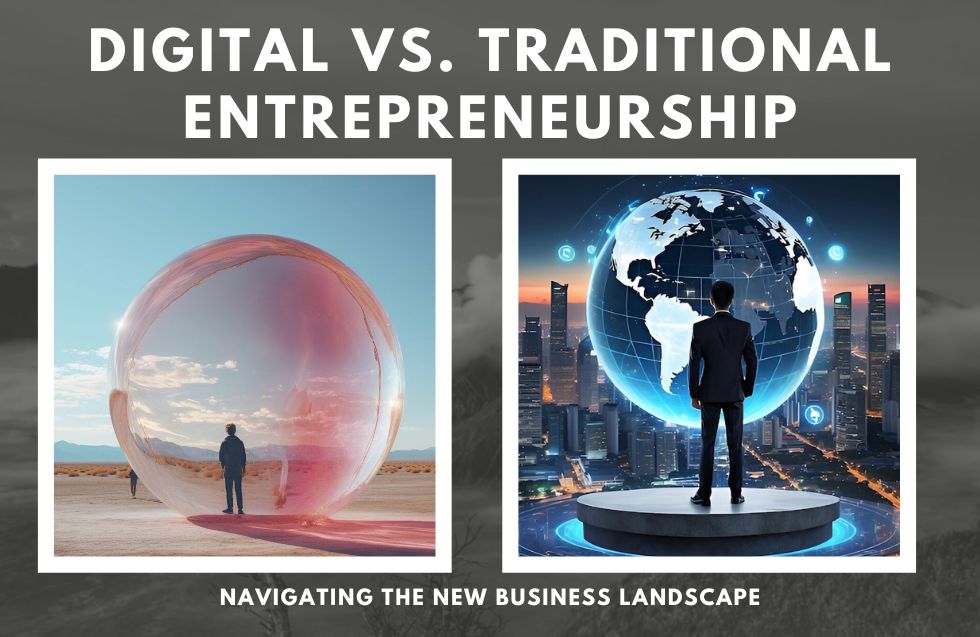In recent years, the landscape of entrepreneurship has transformed dramatically due to technological advancements and the rise of the internet. The debate between digital and traditional entrepreneurship has gained significant traction as aspiring entrepreneurs grapple with how to best establish and grow their businesses. This blog explores the differences between digital and traditional entrepreneurship, their respective advantages and disadvantages, and how entrepreneurs can navigate this evolving landscape.
Understanding the Concepts
Traditional Entrepreneurship
Traditional entrepreneurship refers to businesses that primarily operate in the physical world. These businesses often rely on brick-and-mortar locations and face-to-face interactions. Common examples include retail stores, restaurants, service providers, and manufacturing firms. Traditional entrepreneurs typically engage in long-term planning, establish local customer bases, and maintain physical inventory.
Key Characteristics of Traditional Entrepreneurship:
- Physical Presence: Businesses usually operate from a fixed location.
- Local Customer Base: Focuses on serving local or regional markets.
- Tangible Products and Services: Often involves selling physical goods or in-person services.
- Long-Term Relationships: Builds customer loyalty through personal interactions.
Digital Entrepreneurship
In contrast, digital entrepreneurship encompasses businesses that leverage digital platforms, technologies, and the internet to operate. This includes e-commerce sites, software as a service (SaaS) companies, online marketplaces, and content creation platforms. Digital entrepreneurs utilize online tools for marketing, sales, and customer engagement, often reaching a global audience.
Key Characteristics of Digital Entrepreneurship:
- Online Presence: Businesses operate primarily through digital channels.
- Global Reach: Ability to access customers worldwide.
- Scalable Models: Many digital businesses can scale rapidly without significant additional costs.
- Data-Driven: Utilizes analytics and digital tools to inform decision-making and marketing strategies.
The Advantages and Disadvantages
Advantages of Traditional Entrepreneurship
- Tangible Products: Traditional businesses often deal with physical products that customers can touch and feel, providing a sensory experience that can enhance customer satisfaction.
- Personal Relationships: Face-to-face interactions help build trust and loyalty with customers. Many consumers prefer personalized service and direct engagement.
- Local Market Knowledge: Traditional entrepreneurs often have a deep understanding of their local markets, allowing them to tailor their offerings to meet specific community needs.
- Less Reliance on Technology: Traditional businesses are not as heavily reliant on technology and digital marketing, which can be beneficial for entrepreneurs who are not tech-savvy.
Disadvantages of Traditional Entrepreneurship
- Higher Overhead Costs: Physical storefronts incur costs such as rent, utilities, and maintenance, which can strain cash flow, especially for startups.
- Limited Market Reach: Traditional businesses are often confined to their local areas, limiting growth potential and customer acquisition.
- Slower Scalability: Expanding a traditional business often requires significant investment in new locations and infrastructure.
- Market Vulnerability: Economic downturns or shifts in consumer behavior can significantly impact traditional businesses, which may struggle to adapt quickly.
Advantages of Digital Entrepreneurship
- Lower Start-Up Costs: Digital businesses often require less initial investment than traditional ones, as there is no need for physical storefronts or inventory.
- Global Market Access: Digital entrepreneurs can reach a global audience, allowing for a much larger potential customer base.
- Scalability: Many digital business models can scale rapidly with relatively low incremental costs, especially in sectors like SaaS.
- Data-Driven Insights: Digital entrepreneurs can leverage analytics to understand customer behavior, optimize marketing strategies, and improve product offerings.
Disadvantages of Digital Entrepreneurship
- High Competition: The digital space is crowded, with many entrepreneurs vying for the same audience, making it challenging to stand out.
- Technical Skills Required: Digital entrepreneurs often need a strong understanding of technology, online marketing, and e-commerce, which can be a barrier for some.
- Customer Trust Issues: Online businesses may face challenges in establishing trust with customers, especially if they lack a physical presence.
- Cybersecurity Risks: Digital entrepreneurs must be vigilant against cyber threats, as data breaches can severely impact their reputation and finances.
The Current Landscape
The COVID-19 pandemic accelerated the shift towards digital entrepreneurship. According to a report by McKinsey, the pandemic accelerated the adoption of digital technologies by seven years. Small businesses had to pivot to online sales and digital marketing strategies to survive. A survey by Facebook revealed that 40% of small businesses reported that they had to change their business model during the pandemic, with many transitioning to online operations.
Trends Shaping Digital Entrepreneurship
- E-Commerce Boom: The global e-commerce market reached $4.28 trillion in 2020 and is expected to grow by 26.7% in 2021. This boom presents significant opportunities for digital entrepreneurs to tap into consumer demand for online shopping.
- Social Media Marketing: Social media platforms have become powerful marketing tools for entrepreneurs. According to Statista, 73% of marketers believe that their efforts through social media marketing have been “somewhat effective” or “very effective” for their businesses.
- Subscription Models: Subscription-based services are on the rise, with companies like Dollar Shave Club and Netflix leading the way. The subscription e-commerce market is projected to reach $478.2 billion by 2025.
- Remote Work Opportunities: The rise of remote work has led to an increase in digital services such as virtual consulting, online education, and digital content creation.
Navigating the New Business Landscape
Entrepreneurs must assess their goals, strengths, and target markets to determine whether to pursue traditional or digital entrepreneurship. Here are some strategies to consider:
1. Identify Your Niche
Whether you choose a traditional or digital approach, identifying a niche market is crucial. Conduct market research to understand consumer needs and gaps in the market. This will help you tailor your products or services to meet specific demands.
2. Leverage Technology
For traditional entrepreneurs, incorporating digital tools can enhance operations. This includes using social media for marketing, implementing e-commerce solutions, and utilizing customer relationship management (CRM) systems. Digital entrepreneurs should stay updated on the latest technologies to maintain a competitive edge.
3. Build a Strong Online Presence
For digital entrepreneurs, establishing a robust online presence is critical. This includes having a well-designed website, active social media profiles, and engaging content that resonates with your audience. Utilize SEO strategies to improve visibility and attract organic traffic.
4. Focus on Customer Experience
Regardless of the approach, prioritizing customer experience is key to success. For traditional businesses, this means providing excellent in-store service and personalized interactions. Digital entrepreneurs should focus on creating a seamless online shopping experience and offering responsive customer support.
5. Adapt and Innovate
The ability to adapt and innovate is essential in both traditional and digital entrepreneurship. Stay attuned to market trends and consumer preferences, and be willing to pivot your business model as needed. Encourage a culture of innovation within your organization to continuously explore new ideas and opportunities.
Conclusion
The debate between digital and traditional entrepreneurship is not about one being superior to the other; instead, it is about understanding the unique advantages and challenges each approach presents. As the business landscape continues to evolve, entrepreneurs must navigate these changes thoughtfully and strategically.
Whether you choose to pursue a traditional business model with a physical presence or venture into the digital realm, success lies in understanding your target market, leveraging technology, and adapting to the ever-changing demands of consumers. By striking the right balance between digital and traditional methods, entrepreneurs can thrive in this new business landscape and create lasting impact in their industries.












